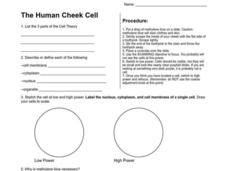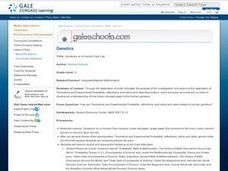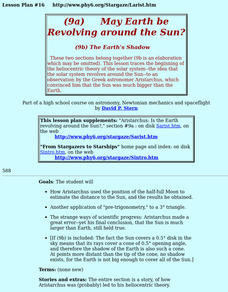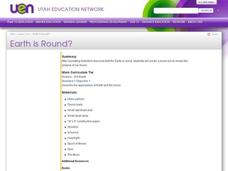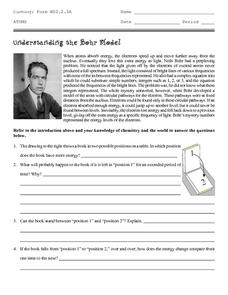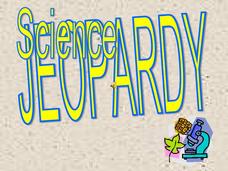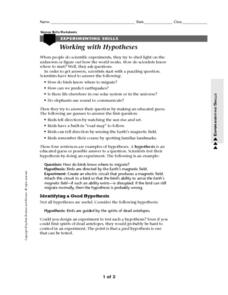Probability Theory Teacher Resources
Find Probability Theory lesson plans and worksheets
Showing 239 resources
Curated OER
What Is Your Explanation for the Evidence?
Students encounter an interactive computer program activity designed as a diagnostic of student beliefs related to the theory of evolution. Students process the Hypercard cascades structured around a set of biological topics related to...
Curated OER
Pascal's Triangle
In this geometry lesson, 10th graders investigate Pascal's Triangles as they relate it to probability problems and geometric problems. They review the theories behind the formulas.
SciShow
Heisenberg Uncertainty Principle
Subatomic particles live in a cloud of probability. The video explains the Heisenberg uncertainty principle and how it relates to this cloud of probability. It also details the observer effect, which is often confused for the uncertainty...
Crash Course
Everything, The Universe...And Life
Are we alone? With thousands of exoplanets orbiting stars near and far, it's a question that has plagued astronomers for many years. Examine the facts and probabilities in a thought-provoking video. The narrator discusses the search for...
Curated OER
Modern Physics, New Phenomena
In this physics worksheet, students examine some of the historical theories of physics through the completion of 11 questions.
Curated OER
Modern Physics, QM
In this physics worksheet, students examine the theory of quantum mechanics through the answering of the nine questions. The answers are accessed through the links by each question.
Curated OER
One Size Fits All, Part 1
Can you tell how tall someone is just by looking at their feet? In this activity, young mathematicians measure their height, arm span, and foot size, graph their findings, and answer questions about how these measurements are related....
Crash Course
Sensation & Perception
To introduce the concept of how sensation influences perception, the narrator of this psychology course, the fifth in a series of 13 videos, presents the case of Dr. Oliver Sacks, a physician that suffers from prosopagnosia. Also known...
Curated OER
The Human Cheek Cell
In this human cells worksheet, 7th graders complete a science experiment using human cheek cells. Students sketch the cells at high and lower power and label the cell nucleus, cytoplasm, and cell membrane.
Curated OER
Variations on a Human Face Lab
Ninth graders gain an application level understanding of probability, symmetry, and ratios and rates that exists in one's everyday environment relative to human genetics.
Curated OER
Birthday Problem
Young scholars identify the probability of an event occurring. Learners explore the complement of an event in finding why an event will not happen. They also explore basics of probability within algebra.
Curated OER
Conditionals Theory
In this conditionals worksheet, students watch videos and complete the sentences with the correct verb tense, and choose the correct option for sentences. Students complete 4 activities.
It's About Time
A Moving Frame of Reference
We often remind pupils to cite their references, but this lesson helps them understand there are many frames of reference. Scholars experiment with throwing a ball straight up in the air and catching it. Then they must do it again...
Veritasium
The Bayesian Trap
Explore an alternative world perspective. Scholars learn the importance of perspective in order to not fall victim to the Bayesian trap. They witness evidence that may alter their current thought processes while watching this episode of...
Be Smart
Why Are There as Many Males as Females?
From anteaters to zebras, why are both sexes equally represented in number? Explore a quirk in evolution with a video from a thought-provoking science playlist. The narrator shows examples of species that might only need a few males,...
Curated OER
The Poetics of Hip Hop
The Bard, Nikki Giovanni, Mos Def? “Sonnet 18,” Ego Tripping,” and “Black on Both Sides”? Sure! It’s the poetics. Class members compare the lyrics, rhythm, and rhyme in classic poetry to hip-hop in a richly detailed resource that...
Curated OER
May The Earth Be Revolving Around The Sun?
Young scholars trace the beginning of the heliocentric theory of the solar system--the idea that the solar system revolves around the Sun--to an observation by the Greek astronomer Aristarchus, which convinced him that the Sun was much...
Curated OER
Earth is Round?
Third graders discuss how Aristotle concluded that the Earth was round. As a class, they review theories about the Earth's shape and describe how life on Earth would be different if it were flat. Individually, they make a moon book in...
Curated OER
Understanding the Bohr Model
In this Bohr model worksheet, students read about Neils Bohr and the model he proposed of the atom. Students answer nine questions about his theory that electrons travel in orbitals and give off energy when they are excited.
Curated OER
Science Jeopardy
Make reviewing evolution, cell division, genetics, cell structure, and scientific method more fun! Science Jeopardy allows teams to choose a category for the question they will address. If you complete the entire game, learners will have...
Domain of Science
The Map of Mathematics
How does all this math fit together? The resource creates a graphical view of the extent of mathematics. The map shows the pure and applied sides of studying mathematics and breaks them down into their many disciplines.
Crash Course
Derivatives
Physics and math are closely associated in the science community. High schoolers use information in the video to determine how derivatives and calculus help them understand our local environment. They complete problems that relate to...
Curated OER
Working With Hypotheses
In this science activity, students examine the topic in order to solidify knowledge covered in the curriculum using puzzles and creative games.
Curated OER
Math Applications
In this math applications worksheet, students solve one word problem that has two parts to it. First, they determine the expected value of a ticket for a prize. Then, student determine the fair price for the ticket purchased and explain...










